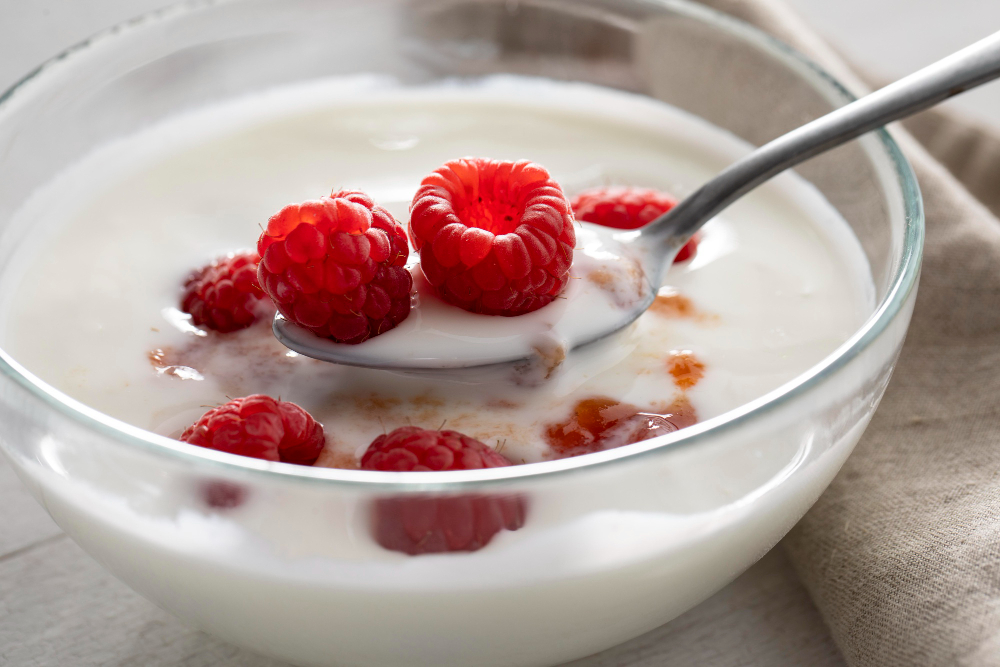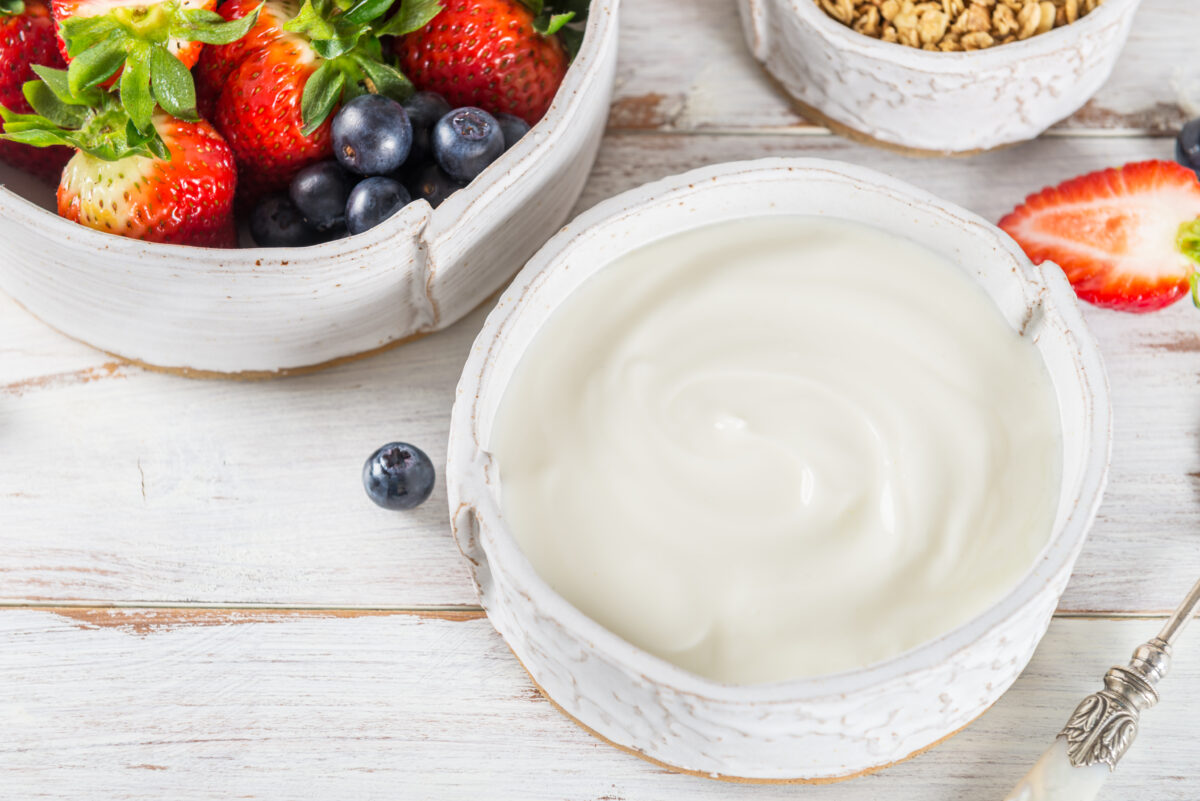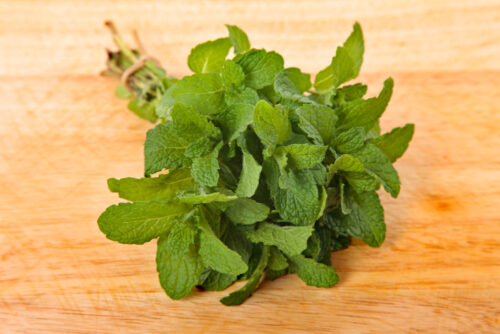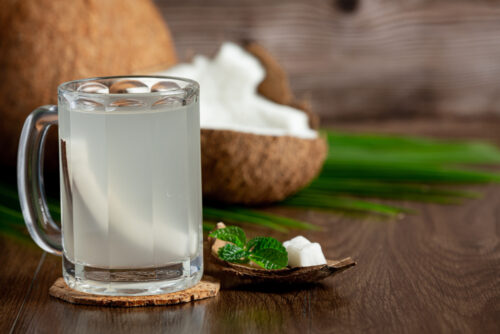Yogurt is a cornerstone ingredient in many kitchens due to its versatility, creamy texture, and tangy flavor.
Many substitutes can fill the gap, whether you’re avoiding dairy, need an alternative for a specific recipe, or simply don’t have yogurt on hand.
This guide will discuss the best dairy and non-dairy yogurt substitutes, their culinary applications, and how they impact your dishes’ texture, flavor, and consistency.
Dairy-Based Yogurt Substitutes
Dairy-based yogurt alternatives often offer similar textures and rich flavors to yogurt, though they may differ in terms of tanginess and creaminess. Below are some popular dairy alternatives:
1. Sour Cream
- Why It Works: Sour cream is more decadent than yogurt, with a fat content of around 35% compared to yogurt’s 4%. Its creamy consistency is similar to yogurt, though it is less tangy. The fat content makes it a luxurious alternative, ideal for adding richness to savory and sweet dishes.
- Best Use: Sour cream is perfect for savory dips, salad dressings, and baked potatoes. It can also replace yogurt in sauces or as a topping for tacos, chili, or soups. While it’s a great stand-in, be mindful of the milder tang, which may affect the overall flavor of your dish.
- Tip: If you need yogurt’s tanginess in a recipe, consider adding a splash of lemon juice or a pinch of vinegar to enhance its acidity.
2. Buttermilk
- Why It Works: Buttermilk is thinner and more liquid than yogurt, providing much-needed moisture and mild acidity. It’s often used in baking because it reacts with leavening agents like baking soda to give a lift to cakes and muffins. Buttermilk’s consistency is also close to yogurt, making it a good stand-in for adding moistness.
- Best Use: It is ideal for cakes, muffins, pancakes, and quick breads. Buttermilk can also tenderize the coating in batters for fried foods.
- Tip: Buttermilk won’t be as thick as yogurt, so it may slightly alter the texture of your dish. If you need a thicker consistency, you can blend in a small amount of cream cheese or use more flour in baking to balance it out.
3. Silken Tofu
- Why It Works: Silken tofu is a creamy, smooth substitute for yogurt that mimics its richness. Its neutral flavor makes it ideal for savory or sweet dishes. Although tofu lacks the tanginess of yogurt, it can be used effectively as a creamy base when blended with lemon juice or vinegar to mimic yogurt’s acidity.
- Best Use: Silken tofu is perfect for smoothies, dressings, sauces, and desserts. Blend it into a creamy sauce for pasta, use it as a base for dairy-free cheesecake, or incorporate it into dairy-free dips and spreads.
- Tip: To add tanginess, blend silken tofu with a little lemon juice, ACV, or probiotic powder to create a dairy-free yogurt-like flavor.
4. Smooth Cottage Cheese
- Why It Works: Cottage cheese has a mild flavor and a slightly chunky texture, which makes it different from the smooth consistency of yogurt. However, blended can provide a rich, creamy base that adds protein and moisture to your dishes.
- Best Use: Cottage cheese can replace yogurt in parfaits, as a substitute for yogurt in savory bowls, or as a spread. It’s excellent in dips and works well for those who like a bit of texture in their dishes.
- Tip: If you’re using cottage cheese in a dessert, blend it until smooth to mimic the consistency of yogurt. It’s also an excellent alternative for those looking to cut down on sugar while still getting a creamy texture.
5. Mashed Bananas or Avocados
- Why It Works: Mashed bananas and avocados are creamy and rich, though they lack the tangy flavor of yogurt. They’re packed with healthy fats and can bring a natural sweetness to your dishes, making them suitable for specific recipes, especially those focused on a smooth texture rather than tanginess.
- Best Use: Avocados and bananas are perfect for smoothies, grain bowls, or topping for oats and parfaits. They can also work as a binder in baking, especially for vegan or dairy-free cakes and muffins.
- Tip: Since they don’t provide the same tartness as yogurt, you can enhance their flavor by adding a small quantity of citrus juice (like lemon or lime) to mimic yogurt’s acidity.
6. Double Cream
- Why It Works: Double cream is thicker and more affluent than yogurt, providing a velvety texture. It lacks the acidity of yogurt but compensates by adding a more indulgent creaminess. Double cream is a great option if you’re looking for something more luxurious.
- Best Use: Double cream is ideal in desserts, particularly custards, mousses, and cakes. It can also be used in sauces, though you may need to balance the richness with a splash of lemon juice to add some acidity.
- Tip: Be careful when substituting double cream for yogurt in recipes. Its richness may overpower delicate flavors. Use sparingly, particularly in sweet dishes.
7. Whipped Cream with Lemon
- Why It Works: Whipped cream can mimic the lightness of yogurt, but it lacks the tanginess. Adding a little lemon juice or zest can infuse it with the necessary acidity to replicate yogurt’s flavor profile.
- Best Use: Whipped cream works best in desserts like pies, cakes, and tarts, where a creamy yet light texture is needed. It also makes an excellent topping for fruit salads and other sweet treats.
- Tip: If you need a thicker consistency, whip heavy cream until stiff peaks form. Add lemon zest or juice to achieve a yogurt-like tang.
8. Ricotta
- Why It Works: Ricotta is creamy and smooth, though it’s a little sweeter and less tangy than yogurt. It’s a great option for adding creaminess without the sharp acidity of yogurt.
- Best Use: Ricotta is commonly used in savory dishes (like pasta) and sweet desserts (like cannoli or cheesecake). It can also be incorporated into scones or baked goods for added moisture.
- Tip: When using ricotta, be sure to blend it well to achieve a smooth consistency. If the texture is too thick, mix it with a little milk or cream to thin it out.
Non-Dairy (Vegan) Yogurt Substitutes

What is a substitute for yogurt? Several substitutes mimic yogurt’s consistency and functionality in recipes for those who follow a plant-based or dairy-free lifestyle. These options also provide the added benefit of being dairy-free and often lower in fat.
1. Cashew ‘Yoghurt’
- Why It Works: When soaked and blended, cashews create a rich, creamy base that closely mimics the smooth texture of yogurt. You can add lemon juice, vinegar, or probiotic cultures to give it a tang.
- Best Use: Cashew ‘yogurt’ is fantastic in smoothies, parfaits, and dips. It can also be used as a base for vegan sauces and dressings.
- Tip: To create a tangy yogurt flavor, add a probiotic capsule or a spoonful of lemon juice and let it sit for a few hours to ferment slightly.
2. Pine Nut ‘Sauce’
- Why It Works: Pine nuts, when blended with a little water or plant-based milk, create a creamy, slightly nutty texture that can easily be used as a substitute for yogurt in many recipes.
- Best Use: Pine nut sauce is ideal for creamy dips and dressings or as a substitute for yogurt in savory dishes. Its delicate, nutty flavor complements Mediterranean and Middle Eastern cuisines.
- Tip: If you want a tangier taste, add lemon juice or a splash of ACV.
3. Avocado or Guacamole
- Why It Works: Avocados are naturally creamy and high in healthy fats. They provide a thick, smooth texture when mashed, though they lack yogurt’s tang.
- Best Use: Great for topping grain bowls, in smoothies, or as a dairy-free base for creamy sauces and dressings.
- Tip: Mix avocado with lemon juice and a pinch of salt to make it more similar to yogurt, creating a creamy, tangy alternative.
4. Hummus
- Why It Works: Hummus is a creamy, savory alternative to yogurt. It’s made primarily from chickpeas and tahini and is ideal for delicious dishes with a tangy or creamy element.
- Best Use: Hummus is perfect for grain bowls, vegetable dips, and wraps. It can also replace yogurt in savory recipes where yogurt’s tang isn’t essential.
- Tip: If the texture of hummus is too thick, dilute it with water or lemon juice to achieve a smoother consistency.
5. Mayonnaise
- Why It Works: Mayonnaise is a rich, creamy option with a slight tang. It lacks the probiotic benefits and acidity of yogurt, so it’s best used in savory dishes.
- Best Use: Use mayonnaise as a substitute in salads, sandwiches, and sauces where yogurt’s acidity isn’t crucial.
- Tip: Add lemon juice or vinegar to the mayonnaise to boost its tanginess and better mimic yogurt’s flavor.
6. Coconut Yogurt
- Why It Works: Coconut yogurt is one of the most popular dairy-free alternatives to traditional yogurt. It offers a creamy texture and a mild tanginess.
- Best Use: Perfect for parfaits, smoothies, and as a topping for fruit bowls or granola.
- Tip: Coconut yogurt can have a distinct coconut flavor, so ensure it complements your recipe before using it in savory dishes.
Conclusion
Plenty of substitutes are available, whether you’re avoiding dairy, experimenting with different textures, or running out of yogurt.
In this article, we studied what to use instead of yogurt, from creamy coconut yogurt to tangy sour cream and rich silken tofu; these alternatives provide endless ways to adapt your recipes without compromising flavor or texture.
Understanding how each substitute works will allow you to continue making delicious dishes, no matter your dietary restrictions or culinary preferences.











